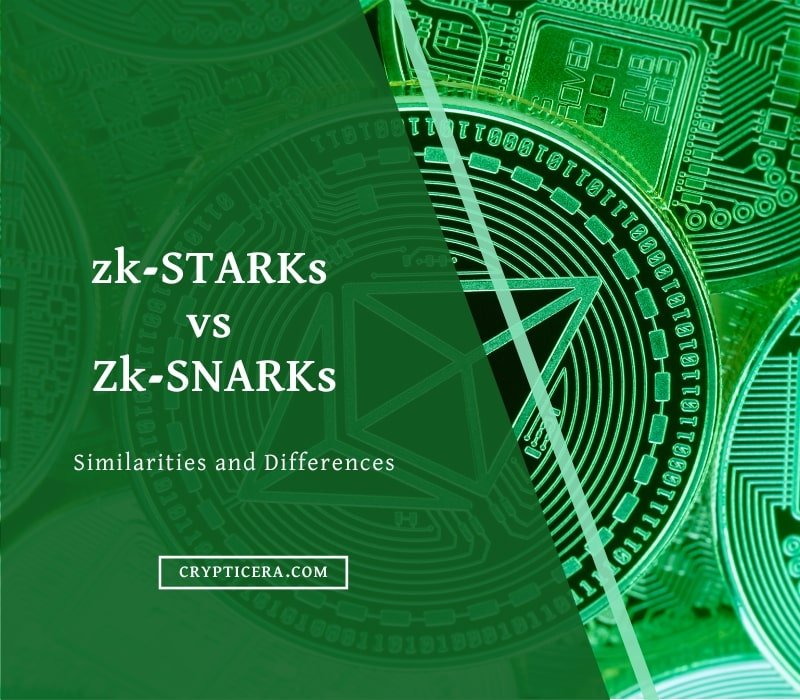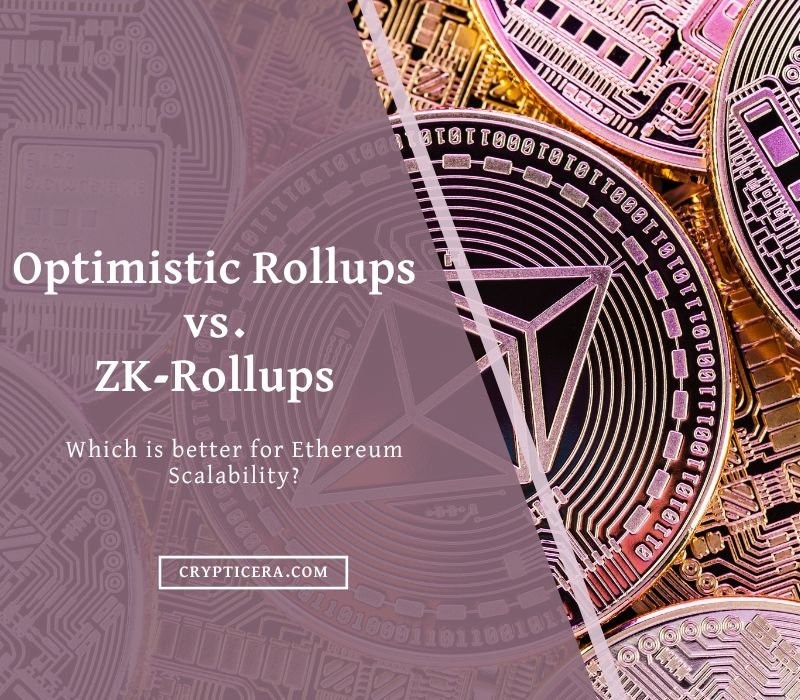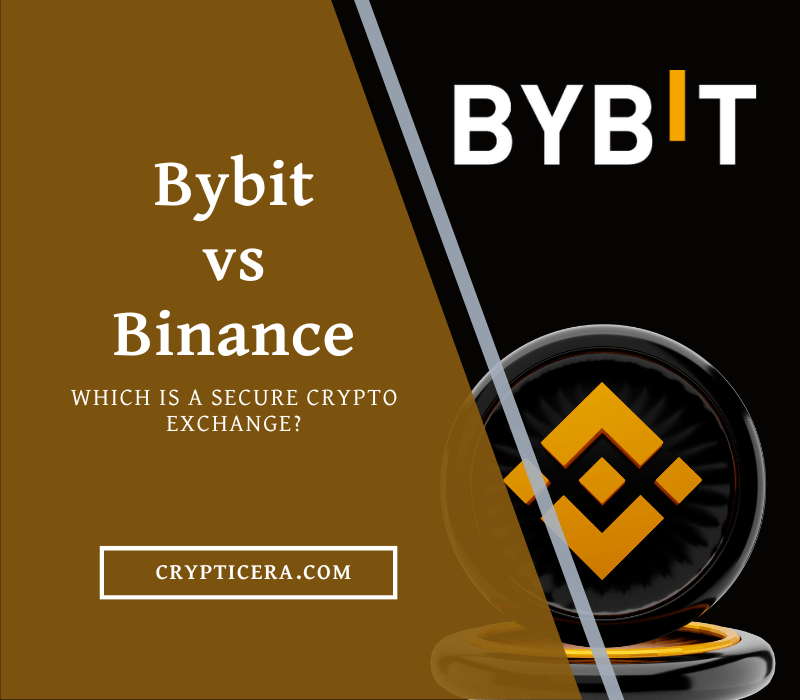As Ethereum continues to grow in popularity, so too does the need for effective Layer 2 scaling solutions.
While there are a number of options available, two of the most highly touted are Arbitrum and Optimism. But which one is the best choice for maximizing Ethereum’s scalability?
In this blog post, we’ll take a deep dive into Arbitrum vs Optimism, comparing their unique features and capabilities to help you make an informed decision.
Arbitrum vs Optimism: At a Glance
| Feature | Arbitrum | Optimism |
|---|---|---|
| Type | Layer 2 scaling solution | Layer 2 scaling solution |
| Technology | Optimistic rollups | Optimistic rollups |
| Consensus mechanism | PoA | PoA |
| Data availability | Available on-chain | Available off-chain |
| Transaction speed | 40,000 tps | 2,000 tps |
| Transaction cost | very Low | Low |
| Native token | – | OP |
| Smart contract support | Yes | Yes |
| Customizable gas costs | Yes | No |
| Privacy | Optional | Optional |
| Language | Solidity, Vyper, flint, Yul+ | EVM solidity |
What is Arbitrum?
Arbitrum is a Layer-2 scaling solution for Ethereum that helps to increase the speed and efficiency of smart contract transactions.
It is able to handle complex contracts and support multiple programming languages while maintaining strong security.
It achieves this through a technique called “optimistic rollups,” which allows transactions to be processed quickly while ensuring that the contract’s final state is valid.
Arbitrum is also a privacy-preserving smart contract platform that is designed to be backward-compatible with Ethereum.
Blockchain URL: Arbitrum
Key Features of Arbitrum
- Scalability: It is designed to scale to thousands of transactions per second, making it suitable for use in high-throughput applications.
- Privacy: Arbitrum allows users to create private smart contracts, which can be executed and verified without revealing the contract code or data to the broader network.
- Backward compatibility: Arbitrum is designed to be compatible with the Ethereum Virtual Machine (EVM), which means that it can run existing Ethereum smart contracts without modification.
- Pluggable consensus: It allows users to choose from a variety of consensus algorithms, including proof-of-stake and proof-of-authority, depending on the needs of their application.
- Modularity: Arbitrum is designed to be modular, with a flexible architecture that allows users to customize the platform to meet their specific needs.
- Security: The platform uses a secure, multi-party computation protocol to ensure the integrity and confidentiality of smart contract execution.
What is Optimism (OP)?
Optimism is a scaling solution for Ethereum that is designed to improve the performance and scalability of the Ethereum network.
It is based on the optimistic roll-up technology, which allows multiple transactions to be bundled and processed in a single batch, rather than being processed one at a time on the Ethereum main chain.
This can significantly increase the speed and throughput of the Ethereum network, making it more suitable for use in high-volume applications.
Blockchain URL: Optimism
Key Features of Optimism
- Scalability improvement: Optimism can achieve a significant improvement in scalability, with the potential to increase Ethereum’s capacity by a factor of 10 to 100 times through the use of optimistic roll-up technology.
- Lower fees: Optimism’s rolling technology allows multiple transactions to be processed in a single batch, resulting in lower fees for users.
- Security: Optimism is built on top of Ethereum and settles transactions on the Ethereum mainnet, providing a high level of security for users.
- Enhanced user experience: With lower fees and faster transaction speeds, Optimism offers an improved experience for users of new projects built on the platform.
Arbitrum vs Optimism: Comparing Similarities and Differences
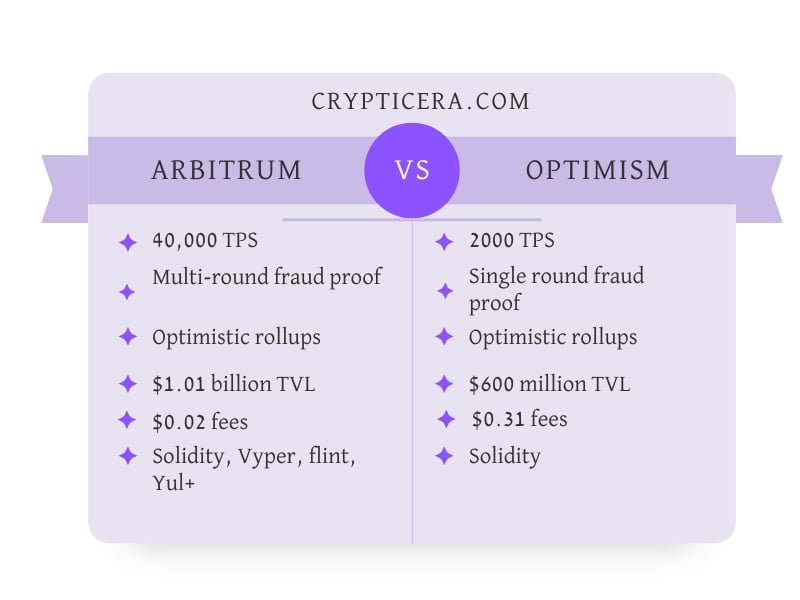
Better Layer 2 Scaling Solution
Arbitrum is a smart contract platform that was built with scalability in mind. Its developers have put in a lot of effort to ensure that it can handle a large number of transactions per second.
It is more suitable for high-throughput applications than Optimism.
In addition to its scalability, Arbitrum also offers enhanced security through the use of multi-round fraud proofs. These fraud proofs ensure that transactions on the network are secure and legitimate, providing peace of mind for users.
On the other hand, Optimism relies on the Ethereum mainchain to execute transactions on its Layer 1, which can be slower and more costly.
This dependency on the mainchain means that Optimism is not as fast or efficient as Arbitrum.
Overall, the design and features of Arbitrum make it a more attractive platform for executing smart contracts, offering a balance of speed, security, and scalability.
Winner: Arbitrum
Transaction Throughput
Arbitrum transactions can be processed without needing to be included in a block. This means that transactions can be executed and finalized much faster than they would be on the main Ethereum chain.
Arbitrum Scalability is 40,000 transactions per second.
Optimism, on the other hand, allows for transactions to be processed in parallel, rather than sequentially, which can lead to faster transaction speeds.
Optimism Scalability is 2,000-4,000 Transactions per second.
Winner: Arbitrum
Total Value Locked (TVL) and Defi Ecosystem
The total value Locked in Arbitrum Defi protocols is $1.01 billion, whereas TVL in Optimism is $511.7 million. (Source: Defillama)
Arbitrum TVL
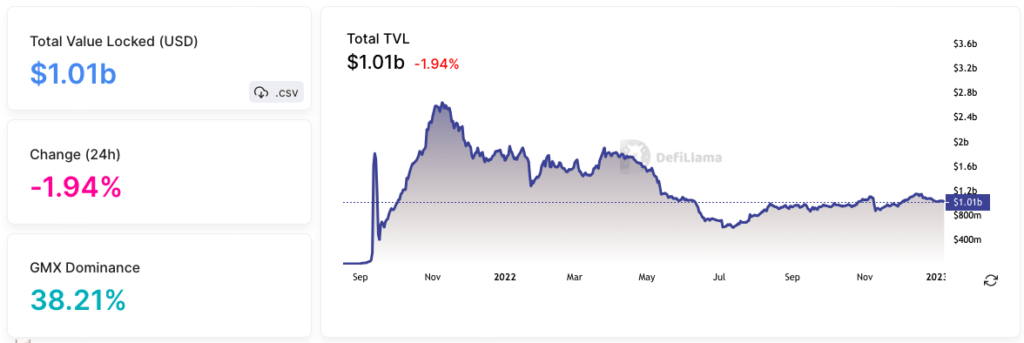
| Name | Category | TVL |
|---|---|---|
| GMX | Derivatives | $385.31m |
| Uniswap V3 | Dexes | $77.9m |
| Sushi | DEX | $75.24m |
| Curve | Dexes | $63.68m |
| Stargate | Cross Chain | $49.92m |
| AAVE V3 | Lending | $48.55m |
Optimism TVL

| Name | Category | TVL |
|---|---|---|
| Synthetix | Synthetics | $89.74m |
| AAVE V3 | Lending | $82.67m |
| Velodrome | Dexes | $77.32m |
| Curve | Dexes | $48.2m |
| Uniswap V3 | Dexes | $42.57m |
What does Layer-2 Scaling Solution Mean?
Layer-2 scaling solutions refer to methods for increasing the transaction throughput of blockchain networks. This should be achieved without changing the underlying protocol (i.e., the “layer 1” of the network).
These solutions typically involve moving some or all of the transactions and their associated data off of the blockchain itself and onto separate, off-chain networks or channels.
Examples of layer-2 scaling solutions include state channels (such as the Lightning Network for Bitcoin and the Raiden Network for Ethereum), sidechains, and plasma chains.
These solutions aim to improve the scalability of blockchains by reducing the amount of data that needs to be stored on the blockchain itself.
Read about Layer-2 Blockchains: Arbitrum vs Polygon
Optimistic Rollups vs. Zero Knowledge Rollups: Which is Better?
Optimistic Rollups (ORs) are a type of layer 2 scaling solution for Ethereum that allows for faster and cheaper transactions by offloading a portion of the computation to a separate layer.
ORs use a mechanism called “fraud proofs” to ensure the validity of transactions and maintain security on the Ethereum main chain.
ORs are considered less secure than Zero Knowledge Rollups (ZKRs) as they rely on a trust model where users must trust that the validator will correctly validate transactions.
ZKRs use a cryptographic technique called “zero-knowledge proofs” to ensure the validity of transactions without revealing any additional information about the transaction.
ORs may be a good choice for users who prioritize fast and cheap transactions and are willing to trade off some security for convenience.
ZKRs may be a better choice for users who prioritize security and are willing to trade off some speed and cost for added security.
Can you bridge from Arbitrum to Optimism?
Yes, it is possible to bridge between Arbitrum and Optimism. Bridging allows users to move assets and data between the two networks, enabling interoperability and greater flexibility in how they can be used.
Some common methods for bridging between the two networks include:
- Using a “relay contract” that allows assets to be transferred between Arbitrum and Optimism by passing through a third, intermediary contract.
- Implementing a “two-way peg” system that allows assets to be locked on one network and unlocked on the other, effectively allowing them to be transferred between the two networks.
- Using an “oracle” service that provides a secure and reliable connection between the two networks, allowing them to communicate and exchange data. This can be done using chainLINK.
Comparison between Single-round and Multi-round Fraud proof Mechanisms
In a single-round fraud-proof, a user submits proof of fraud to the blockchain in a single transaction, and the network reaches a consensus on the validity of the proof based on that one submission.
In contrast, a multi-round fraud-proof allows for multiple rounds of submissions and challenges before the network reaches a consensus on the validity of the proof.
Optimism and Arbitrum are two different blockchain platforms that utilize different approaches for handling fraud proofs.
Optimism uses a layer-2 scaling solution that allows for fast and efficient fraud proofs through the use of an Optimistic Virtual Machine (OVM).
OVM is currently dependable on EVM (Ethereum virtual machine)
Arbitrum blockchain uses its own mechanism of fraud-proof mechanism, which allows for multiple rounds of fraud-proof submissions and challenges.
This allows for a more robust and secure fraud-proof mechanism, but it comes at the cost of increased complexity and a longer time to reach a consensus.
Conclusion
In conclusion, it’s clear that both “Arbitrum vs Optimism” are promising solutions in the world of Ethereum scaling. However, what sets them apart is the approach they take to achieve scalability.
While Arbitrum relies on layer-two scaling to process transactions off-chain, Optimism uses optimistic rollups to keep most transactions on-chain.
Ultimately, both solutions have the potential to greatly increase the transaction throughput of Ethereum, making it a more viable platform for large-scale decentralized applications.
It will be interesting to see how they fare in the future as the Ethereum ecosystem continues to evolve.
FAQs
Are Arbitrum and Optimism different kinds of rollup?
No, Arbitrum and Optimism both use the same “optimistic rollups” to increase transaction throughput. However, the methodology is different.
In a rollup system, transactions are bundled together (“rolled up”) and processed in bulk on the sidechain, rather than being processed individually on the main Ethereum blockchain
Is Arbitrum optimistic or ZK?
Arbitrum uses Optimistic rollups for increasing Ethereum scalability.
What Are Rollups?
Rollups are a type of layer 2 scaling solution for blockchain networks. They allow for off-chain computation of smart contract transactions, while still maintaining the security of on-chain validation.
Transactions are processed on a separate sidechain, known as a roll-up chain, and then “rolled up” into a single on-chain transaction that is submitted to the main blockchain for validation. This allows for multiple transactions to be processed in parallel, greatly increasing the overall throughput of the network.
Rollups can be Optimistic or ZK-rollups, which are different types of rollups with different security and scalability characteristics.
